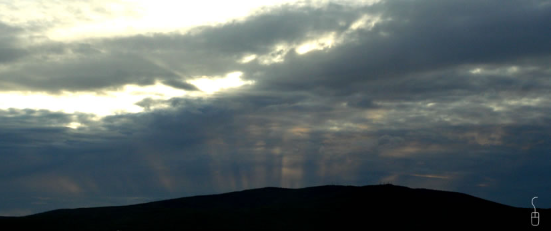Reflected Crepuscular Rays
Reflected Crepuscular Rays: A Phenomenon Explained
Have you ever witnessed a breathtaking display of rays seemingly pointing in two different directions? The phenomenon known as "reflected crepuscular rays" can create this optical illusion. These rays, captured in stunning images by Poul Jensen on September 1st, 2006, near the Geophysical Institute at the University of Alaska, Fairbanks, continue to fascinate scientists and skywatchers alike. In this article, we will delve into the science behind these intriguing rays and unravel the mysteries they hold.
Upon careful examination of Jensen's images, it becomes apparent that the upper white rays originate from a hole in the clouds and point directly towards the sun. However, the lower colored rays defy our expectations by appearing to point downwards, below the hill. How is this possible? Poul Jensen himself provided an explanation for their appearance - they are reflected light crepuscular rays.
To understand the origin of these reflected crepuscular rays, we must turn our attention beyond the foreground hill and towards a group of lakes located 50-70km away in the swampy Minto Flats Game Refuge. It is from these distant lakes that the lower rays are formed. As sunlight strikes the smooth surface of these lakes at a low angle, approximately 70% of the incident light is reflected upwards. These upward-going rays create an illusion of rays emanating from a virtual sun below the horizon.
Now that we have established the source of the reflected crepuscular rays, let us delve deeper into the science behind their formation. When direct rays from the sun penetrate a hole in the clouds, they give rise to the upper white rays that point towards the sun itself. On the other hand, the rays reflected from the distant lakes appear to rise from the virtual sun below the horizon, resulting in the mesmerizing lower orange rays.
It is worth noting that the reflected crepuscular rays are not only a visual spectacle but also hold valuable information about their polarization. These rays are partially polarized, meaning that the light waves oscillate in a preferred direction as they travel through the atmosphere. If you ever find yourself fortunate enough to witness these rays, keep an eye out for any signs of polarization, adding an extra layer of fascination to this already captivating phenomenon.
In summary, reflected crepuscular rays offer a captivating display of nature's optical wonders. Originating from reflected sunlight off distant lakes, these rays create an illusion of dual directions, pointing both towards the sun and downwards below the horizon. As we continue to explore the intricacies of atmospheric optics, let us marvel at the beauty and complexity of the phenomena that surround us. Keep your eyes on the sky, for there is always something extraordinary waiting to be discovered.

Rays pointing in two directions! Mouse over the image - the lower orange red rays point downwards to below the hill, the upper white rays point in a different direction to somewhere in the sky above the hill. Poul Jensen took this and other images on 1st September '06 looking towards Ester Dome from the Geophysical Institute at the University of Alaska, Fairbanks. The sun was 5° high and above the hill but hidden by cloud. What then produced the seemingly impossible lower rays? Image ©2006 Poul Jensen, shown with permission.
Careful measurements of the images show that the upper short white rays from a hole in the clouds point towards the sun. The lower coloured rays have a focus below the skyline and ~5° below the astronomical horizon. Poul Jensen provided the explanation for their appearance. They are reflected light crepuscular rays. They are formed by upward going rays from the reflection of the low sun off a group of lakes 50-70km beyond the foreground hill and in the swampy Minto Flats Game Refuge.

Direct rays from the sun "a" penetrate a hole in the cloulds to form the upper white rays in the image. Rays "b" reflected from the distanct lakes appear to rise from a virtual sun below the horizon to form the lower orange rays. Not so imporbable as it sounds because at that solar altitude, 70% or so of the incident light would be reflected upwards from a smooth lake. The refelected crepuscular rays will be partially polarised - something to look out for if you suspect that you see them. More refelcted rays.
Note: this article has been automatically converted from the old site and may not appear as intended. You can find the original article here.
Reference Atmospheric Optics
If you use any of the definitions, information, or data presented on Atmospheric Optics, please copy the link or reference below to properly credit us as the reference source. Thank you!
-
<a href="https://atoptics.co.uk/blog/reflected-crepuscular-rays/">Reflected Crepuscular Rays</a>
-
"Reflected Crepuscular Rays". Atmospheric Optics. Accessed on April 16, 2024. https://atoptics.co.uk/blog/reflected-crepuscular-rays/.
-
"Reflected Crepuscular Rays". Atmospheric Optics, https://atoptics.co.uk/blog/reflected-crepuscular-rays/. Accessed 16 April, 2024
-
Reflected Crepuscular Rays. Atmospheric Optics. Retrieved from https://atoptics.co.uk/blog/reflected-crepuscular-rays/.